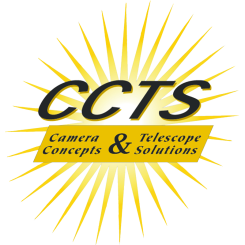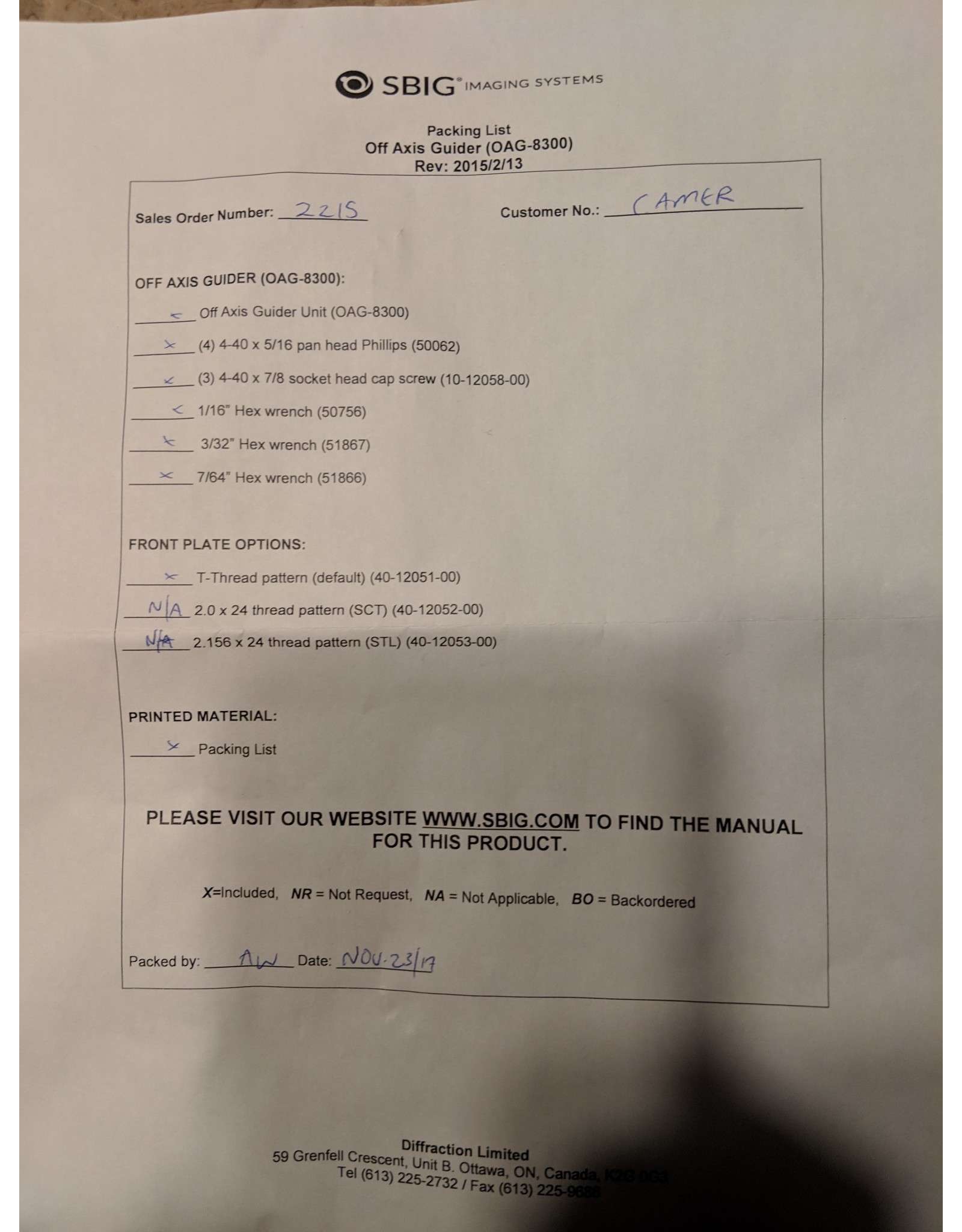SBIG OAG-8300 Off-Axis Guider for ST-8300 and STF-8300 Series Cameras
| Article number: | CN |
| Availability: | In stock |
SBIG OAG-8300
The innovative OAG-8300 turns any STF-8300 into a self-guiding camera system. The OAG-8300 is designed to work with either the 5-position or 8-position filter wheel, but can also be used without a filter wheel by utilizing a Filter Wheel Spacer. The OAG-8300 is backward compatible with all ST-8300 models. What is unique about the OAG-8300 is the 7-element internal optical design. The OAG contains relay optics that move the guide camera to the side of the imaging camera, and at the same time, a 0.7X reducer effectively doubles the field of view of the guider. This design allows for a low profile between the camera and the telescope, reducing backfocus requirements, and at the same time, gives a wide field of view that offers more guide stars for the guide camera.
Note: If you are not planning to use a filter wheel with the OAG-8300, then you must use the Filter Wheel Spacer accessory. The spacer takes the place of the filter wheel and is required for mechanical compatibility with the camera. If you are using a filter wheel then the spacer is not required.
SBIG STi-c
The ST-i Planet Cam and Autoguider adds features unavailable elsewhere in a camera of this size and price. A high performance compact camera that is an excellent guider and very capable Planet Camera. The body is light weight, no larger than many 1.25" eyepieces. In fact, it is 1.25" in diameter, 3.5" long and weighs only 2.2 ounces. The camera receives both control signals and power from the USB port of your computer, so only one thin USB cable is required for using the camera as an imager. For guiding, a standard, opto-isolated, autoguider output port is located in the back panel.
KODAK KAI-340 CCD - Mono or Color
Rather than using a low cost CMOS sensor (with high noise), the ST-i uses a high quality, low noise, Kodak CCD. The KAI-340 CCD has a measured read noise of only 9e- in the ST-i camera. This is the same CCD used as the guiding sensor in the new STX series cameras and the AllSky-340 cameras. The array is 648 x 484 pixels at 7.4 microns square. Anti-blooming is standard. SBIG uses only the Class 1 version of this CCD with 0 column defects, 0 cluster defects, 0 dead pixels, and 0 saturated pixels, all according to Kodak specifications. On-chip binning is available for 14.8u pixels if desired, and various sub-frame modes may be used to speed-up the focus and download rates. A full frame high res image will update at the rate of approximately 5 frames per second. In addition to full-frame, half-frame and quarter-frame modes, the user may select a sub-frame region of interest (ROI) of any size located anywhere on the CCD. In focus mode, using a 20 x 20 pixel box the update rate is greater than 20 frames per second. This sensor is available in monochrome or color.
Kodak describes the performance of this CCD: "Designed for demanding imaging applications, this sensor has additional features including electronic shuttering, peak QE (quantum efficiency) of 55%, extremely low noise and low dark current. These features give this sensor exceptional sensitivity and make it ideal for machine vision, scientific, surveillance, and other computer input applications."
ELECTRONIC AND MECHANICAL SHUTTERS
This sensor has an electronic shutter allowing exposure times as short as 0.001 seconds. Most other eyepiece sized cameras rely on this type of "global" shutter alone due to the difficulty and cost of building an additional mechanical shutter into the camera body. However, in the ST-i camera SBIG has also included a mechanical shutter enabling the camera to automatically take dark frames. This feature alone dramatically improves the performance of the ST-i, particularly when used as an autoguider. Cooling of the CCD to reduce dark current is unnecessary at the short exposure times common to planetary imaging and autoguiding, but there remains the possibility of bright pixels in an image that can raise the threshold of brightness required for the most sensitive guiding performance. The ability to automatically take and subtract a dark frame results in a very smooth background against which detection of dim stars is more reliable. Finally, while some inexpensive guiders save cost by using low cost 8 bit or 10 bit electronics, the ST-i camera uses a high quality 16-bit A/D for superior resolution of the full dynamic range of the CCD, greater than 70 dB














